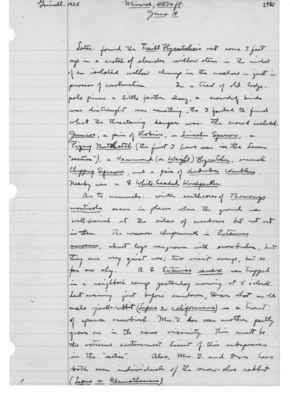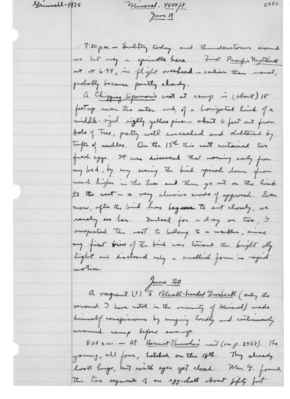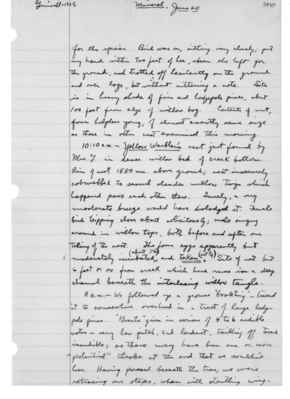Pages
S2 Page 25
Author: Grinnell-1925 Location: Mineral, 4800 ft. Date: June 19 Page Number: 2480
Later: found the Traill Flycatcher's nest some 7 feet up in a crotch of slender willow stem in the midst of an isolated willow clump in the meadow - just in process of construction. In a tract of old lodge pole pines a little farther along, a crowd of birds was distraught over something, tho I failed to find what the threatening danger was. The crowd included: Juncos, a pair of Robins, a Lincoln Sparrow, a Pigmy Nuthatch (the first I have seen in the Lassen "section"), a Hammond (or Wright) Flycatcher, several Chipping Sparrows, and a pair of Audubon Warblers. Nearby was a (female) White-headed Woodpecker.
As to mammals: winter earthcores of Thomomys monticola occur in places where the ground is well-drained at the sides of meadows but not out in them. The common chipmunk is Eutamias amoenus, about logs overgrown with snowbushes, but they are very quiet now; two visit camp, but so far are shy. A (female) Eutamias senex was trapped in a neighbor's camp yesterday morning at 5 o'clock. Last evening just before sundown, Dixon shot an old male jack-rabbit (Lepus c. californicus) in a tract of sparse snowbush. Mrs. G. has seen another partly grown one in the same vicinity. This must be the extreme easternmost limit of this subspecies in the "section". Also, Mrs. G. and Dixon have both seen individuals of the snow-shoe rabbit (Lepus w. klamathensis).
S2 Page 26
Collector: Grinnell-1925 Location: Mineral, 4800 ft. Date: June 19 Page Number: 2481
3:00 p.m. - Watched a White-headed Woodpecker drink. It flew down from a yellow pine to some shallow running water in an open road-side, alighted in horizontal position on the ground, and dipped it's bill 6 times, after each dip raising its billed skyward at an angle of fully 80 degrees from the horizontal. The bird then flew to a prostrate log, and foraged horizontally along its lower curvature.
5:00 p.m. - Mrs. G found a Mountain Quail's nest yesterday with two eggs in it, and we showed it to Dixon. This was close to a flycatcher's nest which Dixon is photographing; and he found that the third egg was laid this morning between 8 and 9. At 4 this afternoon he reported all the eggs gone. I came over to see if I could learn the cause of the loss. Examination disclosed all three eggs there, but covered up all but a small part of the surface of one egg, by the fine ceanothus leaf (dry) litter! Had the quail done this intentionally, like a grebe? I doubt it; so I have left the eggs in their hollow uncovered, so they will be in sight to "lay to" tomorrow. This is merely my theory! The "nest" is merely a depression in the dry loose litter on top of a prostrate rotting log, overspread from one side with ceanothus cordulatus stems, twiggery and green leafage. The nest is 480 mm. above the ground on either side of the log. We have seen the quail within 50 yards of the site several times.
S2 Page 27
Collector: Grinnell-1925 Location: Mineral, 4800 ft. Date: June 19 Page Number: 2482
7:30 p.m. - Sultry today and thunderstorms around us but only a sprinkle here. First Pacific Nighthawk out at 6:45, in flight overheard - earlier than usual, probably because partly cloudy.
A Chipping Sparrow's nest at camp is (about) 18 feet up near the outer end of a horizontal limb of a middle-sized sickly yellow pine - about 6 feet out from bole of tree, pretty well concealed and sheltered by tufts of needles. On the 13th this nest contained two fresh eggs. It was discovered that morning early from my bed, by my seeing the bird spiral down from much higher in the tree and then go out on the limb to the nest - a very elusive mode of approach. Even now, after the bird has begun to sit closely, we rarely see her. Indeed for a day or two, I suspected the nest to belong to a warbler, since my first view of the bird was toward the bright sky light and disclosed only a smallish form in rapid motion.
June 20. A vagrant (?) [male symbol] Black-headed Grosbeak (only the second I have noted in the vicinity of Mineral) made himself conspicuous by singing loudly and continuously around camp before sun-up.
8:00 a.m. - At Hermit Thrushes' nest (see p. 2468). The young, all four, hatched on the 18th. They already look huge, but with eyes yet closed. Mrs. G. found the two segments of an eggshell about fifty feet
S2 Page 28
Collector: Grinnell - 1925 Location: Mineral, 4800 ft. Date: June 20 Page Number: 2483
along the open cow-trail from nest, to which point we surmise the (female) thrush had carried them, then attached together at one part of the periphery. They were on the ground; color and size make them hermit thrush and nothing else. The adult just appeared with insects in bill, but proves shy.
The Mountain Chickadee brood (p. 2469) had left their nest this morning, and were scattered about in the snow-brush, even though rather feeble of flight. One I tried to catch hid himself down in the tangle effectually.
8:30 a.m. - We are trying to line up the flight of a Pileated Woodpecker thru the (unknown1). He has passed each way along a definite route, with nest probably at one end or the other. We are struck with the bird's quietness of flight even when passing within 100 feet over head. There isn't the faintest swish of wings, as, for instance, with a crow. If we hadn't seen the Pileate we would have known nothing of its transit, for it gave no note.
8:45 a.m. - Just found another Hermit Thrushes' nest: rim 1090 above ground; of usual construction, beside a small fir, but entirely supported by the stem and twigs of a broken-down young cedar. Easily seen for 50 yards in any direction. Of usual construction.
S2 Page 29
Collector: Grinnell-1925 Location: Mineral Date: June 20 Page Number: 2484
for the species. Bird was on, sitting very closely; put my hand within two feet of her, when she left for the ground, and trotted off hesitantly on the ground and over logs, but without uttering a note. Site is in heavy shade of firs and lodgepole pines, about 100 feet from edge of willow bog. Contents of nest, four helpless young, of almost exactly same size as those in other nest examined this morning.
10:10 a.m. - Yellow Warbler's nest just found by Mrs. G. in dense willow bed of creek bottom. Rim of nest 1580 mm. above ground; nest insecurely cobwebbed to several slender willow twigs which happened pass each other there. Surely, a very moderate breeze would have dislodged it. Female bird tripping very close about solicitously; male singing around in willow tops, both before and after our taking of the nest. The four eggs apparently but moderated incubated (about 1/2) and taken (set 1/4). Site of nest but 6 feet or so from creek which here runs in a deep channel beneath the interlacing willow tangle.
11 a.m. - We followed up a grouse "boonting"- traced it to somewhere overhead in a tract of large lodge pole pines. "Boonts" given in series of 4 to 6 audible notes - very low pitch, 2nd loudest, trailing off toward inaudible; so there may have been one or more "potential" throbs at the end that we couldn't hear. Having passed beneath the trees, we were retracing our steps, when with startling wing-




